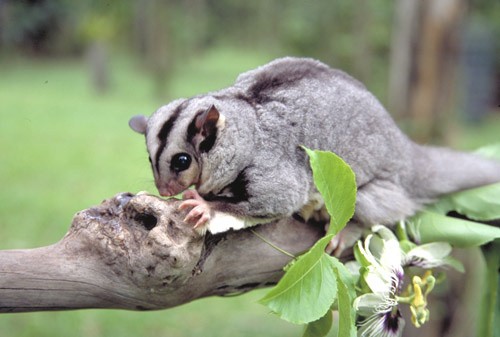Daryl Dickson listens for a shower of drops shaken loose from the leaves above if there has been rain and it is after dark.

When everything is dry, it might be the faint sound of bloodwood flower caps dropping on her roof that sends her running for a torch in search of one of her elusive marsupial friends.
"I don't think there's anything more beautiful than watching a large mahogany glider fly above your head. She says, "I just think they're gorgeous."
Dickson had no idea she was sharing her home with a rare creature when she came to Meunga Creek in Cardwell in far north Queensland about 30 years ago.
She discovered that her block is not the "rubbish scrub," as her real estate agent described.
Instead, it is a prime and fragile habitat for the mahogany glider, living a precarious presence on Earth on a tiny but fragmented stretch of coastal woods just 120km long.
Gliding Marsupials
There are seven possum-like gliding marsupials in Australia, but the mahogany is the most endangered.
One of the first known specimens was obtained by a Queensland Museum collector near Cardwell in 1886. It languished in a drawer without being classified as a distinct species.
Staff questioned if this much bigger specimen may be a different species when the museum moved in 1986. After going to the spot again, employees ultimately recovered the glider four years later. The term mahogany stems from its hue and the swamp mahogany tree - one of the key species in its ecosystem.
The gliders, which grow up to 28cm long and have tails up to 41cm in length, reside in tree hollows and appreciate open wet forests and tea-tree swamps, but roughly 80 percent of their habitat has been destroyed.
Related Article : Mass Extinction Hits Australia With The Death of 13 Species
Displaced Species
What's left is extensively divided by agriculture and human development. The glider habitat has now been fragmented into about 1,000 parts.
The final assessment stated no more than 2,000 humans remained. Before Cyclone Yasi in 2011, one of the state's most violent known cyclones, which destroyed the glider's small bolthole, that count was taken.
"Since typhoon Yasi, we're not sure how many there are," says Andrew Dennis. He oversees a five-year mission to conserve the glider at Terrain NRM, an environmental management company.
"It's challenging to catch them." They eat mainly on nectar and tree sap, and it's relatively hard to get them attracted to the bait."
Tracking
Raspberry cordial has proven to be the finest bait for the mahogany gliders thus far. Dennis explains, "We have to spray quite a bit of it around the camera and the cages."
Gliders might have been hidden for a few thousand years on Hinchinbrook Island, a remote national park less than 10 kilometers off the shore, undiscovered by humans.
According to Dennis, modeling the glider's habitat reveals the island offers "excellent grade mahogany glider habitat."
A crew put up 20 camera traps on the island for six weeks and brought them in the right before Christmas.
A sugar glider, a smaller near relation of the mahogany, was sighted in the final hours before the cameras were removed, but there were no mahogany gliders spotted.
Over thousands of years of seclusion, how much might the gliders have changed? Could they have made it out alive? She believes she'll be able to research the questions.
Hinchinbrook might be a possibility in the future as a haven for certain mahogany gliders to live without many of the risks that they experience on the mainland, even if mahogany gliders are not present on the island, Dennis adds.=
For the most recent updates from the animal kingdom, don't forget to follow Nature World News!
© 2025 NatureWorldNews.com All rights reserved. Do not reproduce without permission.





